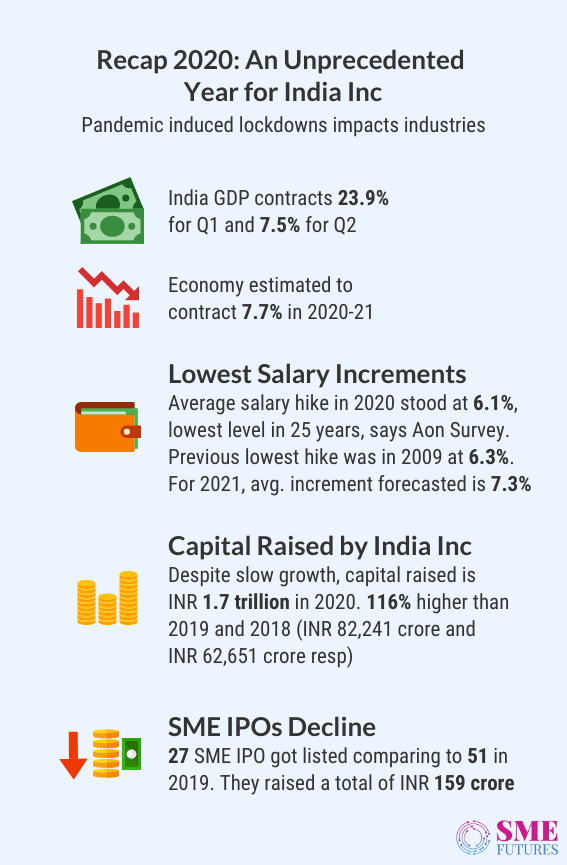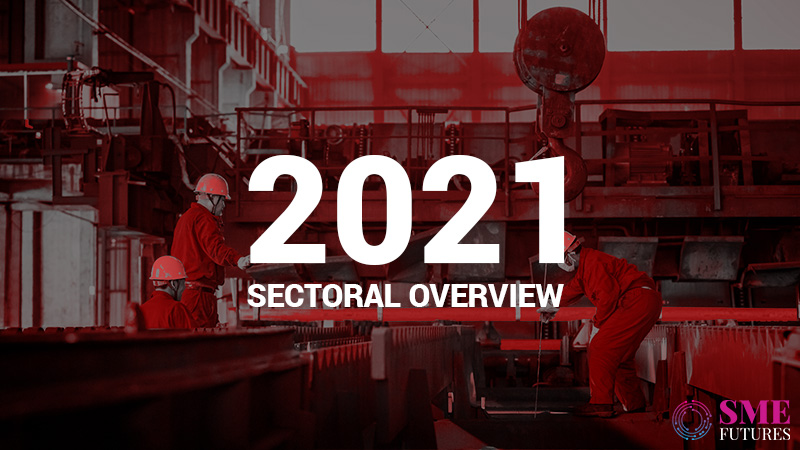2020 was an unprecedented year which will never be forgotten in the history of mankind. As the government imposed nationwide lockdown in late march to combat the spread of novel coronavirus, havoc was wrecked on various sectors due to prolonged closures. From manufacturing to hospitality and airlines to mining, many sectors were adversely impacted which resulted in sharpest drop of economy since 41 years.
Reeling under the effect of pandemic, corporates, entrepreneurs, MSME businesses, informal workers, all struggled to adapt to the untimely and extremely uncertain situations. While some sectors were able to optimally utilize adverse situations to their benefit, other sectors faced major setbacks due to discontinuity in demand-supply chain, safety concerns of customers, and prolonged closures of their sales outlets or manufacturing units.
As 2021 approaches, most of the global think-tanks and Indian research houses are predicting a positive cyclic outlook. The Organization for Economic Co-operation and Development (OECD) expects Indian economy to grow by 7.9 per cent during this year. It had earlier registered a contraction of 9.9 per cent during FY 2020-21. Meanwhile, NITI Aayog said that economy will reach the pre-COVID level by the end of 2021 and it has predicted a growth of 10 per cent.

A ray of hope in the coming year
“2021 has brought a ray of hope and optimism for all. Effective vaccines are expected to bring both life and economy back on growth trajectory with a v-shaped recovery in the world trade. Arrival of vaccines has also helped in boosting business sentiments for the sector as a whole. This will be further seen from positive figures in coming months.”
Sharad Kumar Saraf, President, Federation of Import Export Organisations (FIEO)
In terms of export, December saw a marginal decline of 0.8 per cent with US$ 26.89 billion of exports. The signs of revival were also visible as order booking position continuously improved along with prospective new orders. Saraf said that monthly exports have moved towards positive territory as major export products have depicted signs of further revival.
FIEO President further told that December exports also signals that this labour-intensive sector has surpassed its most challenging and testing times. The sales during festive season have shown positive trends with a promise of further improvement in coming months. Now the inventories are expected to be liquidated, adding further to the overall demand.
However, there are some key issues that need readdressal in this arena. This includes adequate availability of containers, softening of freight charges, release of the required MEIS, clarity on SEIS benefits, resolving risky exporters issues, introduction of NIRVIK scheme, addressing long pending demand about creation of an Export Development Fund and resolving various other infrastructural bottlenecks. This will not only help in boosting exports in FY’ 2020-21 but will also give a fillip to it in the new fiscal.
Retail witnesses a positive return in consumer spending
Unemployment and steep decline in revenues have deepened troubles for retailers. This has casted a dark shadow over consumers and companies trying to refinance debt or cut acquisition deals. In addition to this, consumer spending has contracted by 12.6 per cent in 2020. But as a respite for retailers, Fitch solutions predict a positive return of spending.
According to the firm, household spending in India is expected to grow in 2021 after a stark contraction in consumer spending during 2020 due to pandemic related budgetary constraints. In nominal terms, total household spending will only be 1.2 per cent higher than what it was in 2019 (Rs 123 lakh crore in 2021 compared to Rs 121.6 lakh crore in 2019). This indicates the extent of impact that the pandemic had on consumer spending.
On this note, Kumar Rajagopalan, CEO, Retailers Association of India (RAI) comments that festive season has instigated revival of the sector.
He claims, “The festive season provided the much-required tailwind to retail industry of India which is now witnessing a steady month-on-month improvement. Retailers are hopeful of achieving about 85 per cent of pre-pandemic levels of business in the first six months of the year 2021.”
Although, COVID-19 vaccinations have started globally, the control of spread of disease may still take considerable time. Retailers should thus move ahead with cautious optimism in 2021. He further states, “Retail in India which is sized around USD 854 billion continues to be one of the country’s largest industries. It makes up for over 10 per cent of the GDP. We believe that the recovery of this sector will need unconventional solutions and extensive government support.”
Talking about the growth of luxury retail, Pankaj Khanna, Founder & MD, Gem Selections, Khanna Gems Pvt Ltd tells that companies which adapted faster were able to survive the uncertain season.
He adds, “2020 was a tough year for the retail sector especially in the luxury goods and services section. Three months of lockdown led to huge revenue loss. Companies that adapted to changing needs and technology were able to make profits.”
Automobile sector is cautiously optimistic
The Indian automotive industry severely plunged down with nation-wide lockdowns. According to an estimate, the industry suffered losses of more than Rs 2,300 crore in turnover. This loss was accounted for on every single day of closure. Sales of passenger vehicle fell by 78.43 per cent in the period between April-June 2020. The sector also saw a decline for the ninth straight quarter which makes it a longest slowdown in twenty years.
Meanwhile, the pandemic led to drastic change in the sector. To cope up with losses major auto sector players embraced digitization and introduced new normal SOPs to serve customers.
Pankaj Tiwari, Chief Marketing Officer, Nexzu Mobility, an EV maker says, “The pandemic forced companies to reinvent their business approach in order to keep afloat. The changed circumstances led the leadership and management of company to reorganize roles and functions of the workforce.”
Despite a slump in four-wheeler section, the preference for personal mobility in the form of two-wheelers pushed auto sector to gain some momentum. Rajesh Menon, Director General of the Society of Indian Automobile Manufacturers (SIAM) notes, “While the festive season brought back some fervor in specific segments, the overall economic scenario would determine the industry’s performance going forward.”
The country’s second largest car maker Hyundai Motor India Ltd (HMIL) is also hopeful of some economic recovery of the sector next year. This in turn would fuel the growth of auto industry. “Looking ahead, the company is cautiously optimistic about the future as it clearly spots some green shoots of recovery in 2021,” said HMIL MD and CEO S S Kim in a media statement.
Tiwari of Nexzu Mobility feels that though manufacturing and automobile sectors faced maximum brunt, it emerged strongly once the unlock phase started. “The Government’s Aatma Nirbhar Bharat movement and stimulus to promote domestic manufacturing has led to increased focus on localization,” he professes.
According to him, the changes within automotive sector have led to growing inclination towards personal, safe, and cost effective mode of commuting and travel. Thus, two-wheelers in electric vehicles segment that address environmental conservation and sustainability took a centre-stage among the corridors of power and across boardrooms.
Long road ahead for the real estate sector
India’s real estate sector was in revival mode since demonetisation. The spread of pandemic acted as another severe blow for the industry. Data compiled by property consultant Anarock tells that housing sales fell by 47 per cent year-on-year to 1.38 lakh units in 2020 across top seven cities. These cities include Delhi-NCR, Mumbai Metropolitan Region (MMR), Bengaluru, Hyderabad, Pune, Chennai and Kolkata.
The net leasing of offices is estimated to fall at 25-27 million square feet in 2020 from a whopping 46.5 million square feet in 2019, according to JLL India. Work from home mode during the lockdown added to these woes. “The real estate sector has been facing headwinds for past few years. The situation became worse owing to COVID-19. Uncertainty over jobs and livelihoods robbed the market of its potential buyer-base leading to near-zero demand,” said CREDAI President Satish Magar in a media statement.
According to him, sales have improved after end of the lockdown phase but are yet to touch pre-covid levels in most cities. However, efforts from many fronts emerged to resurrect the sector. For instance, the government invoked force majeure clause under the Real Estate (Regulation and Development) Act (RERA) to extend the deadline for completion of projects by six to nine months. This step helped developers in wading through the crisis.
Interest subsidy for middle-income group was extended till March 2021. Furthermore, a scheme was launched to provide homes to migrants or urban poor at an affordable rent. One-time loan restructuring was also allowed. Adding to that, Section 43 CA of income tax act was relaxed. Also, investment of Rs 10,000 crore has been approved under SWAMIH stress fund but many builders complained about tough eligibility criteria to secure these funds.
Surendra Hiranandani, Chairman and Managing Director, House of Hiranandani tells that the residential sector has bounced back faster than expected with the help of various financial waivers by the government. But, he feels that a lot needs to be done for the sector to improve the momentum of growth.
“Along with affordable housing, we also need to provide incentives for housing in sustainable developments. These are the need of the hour in urban spheres. A series of measures in the form of capital injection, refinancing of banking institutions, policy impetus, subsidies, tax benefits and offers are required to see a faster recovery. The market is robust and in the coming months, we expect a rise in the growth momentum,” he adds.
The uncertain times also diverted home buyers to reputed and branded developers who are trustworthy and provide quality products. The new requirements such as work-from-home space, quarantine facilities, and online education have also prompted buyers to opt for larger living spaces. Digitisation of the real estate sector was a remarkable transformation that the year witnessed after the lockdown.
Infrastructure sector optimistic about its growth
Infrastructure propels a country’s overall development and growth. Hence, it expects government to come up with policies that would ensure a time-bound creation of world class facilities. According to IBEF, India requires investment worth Rs 50 trillion (US$ 777.73 billion) in infrastructure by 2022 to boost sustainable development.
However, the industry has witnessed a contraction of 50.3 per cent in real terms during the second quarter due to the pandemic related constraints. Overall, the shrink was approximately 15 per cent in 2020. But various industry forecasts predict a sharp growth of 11.6 per cent in year 2021. Invest India estimates that India’s construction sector is poised to become third largest globally by 2025 with output expected to grow by 7.1 per cent per year.
Karandeep Sheoran, Managing Director, E5 Infrastructure talking about this says, “Most industries face a scarcity of human resources in the form of unskilled and semi-skilled workers. This resulted in constant delays throughout the supply chain and in execution. However, Nitin Gadkari, Ministry of Road, Transport, and Highways (MoRTH) released new policies and initiatives which allowed an effective and efficient execution of EPC contracts.”
He further adds, “Due to the overall support of MoRTH for EPC Contractors, 2020 has seen the largest number of entrants in the industry. With the recent announcement by MoRTH, barriers to entry have been drastically reduced through a relaxation in qualification criteria for any EPC contractor. This has resulted in a storm of new players and therefore has led to an increased competition. E5 is hopeful and believes that 2021 will be incredibly fruitful for the industry.”
HVAC&R witnesses sudden spike in innovations
Increasing consumers in the healthcare, pharma, food, and other sectors has created immense opportunities for heating, ventilation, and air-conditioning market. The rising need for energy-efficient HVAC&R systems and surging dehumidification (moisture control) needs across industries and growing replacement demand for HVAC&R systems will drive industry’s growth in the near future.
According to Dinesh Gupta, Director, Bry-Air (Asia), the need for intelligent HVAC products is increasing day by day as people are cautiously stepping out for work. Technologies such as Artificial Intelligence (AI), Internet of Things (IoT), remote control access, and automated control systems are transforming the HVAC&R and de-humidification equipments.
2020 will be counted as a tough year, but Bry-Air has now sailed through difficult times because of its vast range of diverse products catering to varied industries. Gupta further tells, “Demand from pharmaceutical and food processing companies kept us going and sub-sectors such as Rapid Diagnostic kits and COVID test kits, nutraceutical (health supplements), and very recently APIs along with demand of packaged food have boosted the demand.”
He professes, “The economy is recovering and we have already started seeing the positive signs. However, comparing last year’s performance with others would not be fair. But, there is a belief that we will reach the pre-COVID level by the second half of this year if another wave of coronavirus didn’t strike us. The beginning of vaccination drive in India adds to our optimism.”
Transformation of ed-tech and learning processes
The year 2020 marked a paradigm shift in the arena of conventional learning processes. With the digitalisation of teaching-learning processes, the new normal brought a new dawn in this segment. Amid the suspension of classroom teaching, online learning emerged as the universal remedy to maintain the momentum of education. The year also witnessed execution of the National Education Policy 2020 that underlines measures to make education skill-oriented.
Rohit Manglik, CEO, EduGorilla foresees the momentum to sustain in 2021 along with the implementation of AI in learning tools. He adds, “Besides artificial intelligence, we foresee gamification and cloud technology to drive engagement and boost the user experience in e-learning. Tier 2 and tier 3 cities will emerge as favourable destinations for ed-tech players and account for a substantial customer base of ed-tech.”
In the similar vein, Kiran Dham, CEO, Globus Infocom comments that students and faculty across educational spectrum have adapted to remote or online learning now. “Advanced technologies like cloud based learning and app based learning etc have helped students and teachers in not missing on the classroom learning experience. Apart from K-12 education, professionals and college students have also turned to Ed-tech for vocational training.”
On the trends in 2021, Dham adds that “The education industry will further evolve in terms of technological advancements and revised pedagogical methods. The norms which have been established will sustain for better. Schools and colleges (both private and government) will be collaborating with education technology companies to leverage digital aids like AI based learning resources, online assessments, and analytical thinking digital tools.”
IT/ITeS developing fast with enhanced opportunities
2020 was a golden period for Indian IT and ITeS sector. The trends of new normal such as WFH mode gave boost to various IT services with adoption of technology at a higher rate. According to Garima Goenka, Market Analyst, IT Services, IDC India, “In 1H20, the role of IT Services vendors gained higher prominence, as organisations increasingly approached them to help ensure business continuity by putting in place various technologies, solutions, best practices and frameworks.”
The IDC’s Worldwide Semiannual Services Tracker-1H20 states that the Indian IT and business services market grew by 5.3 per cent (on-year) as compared to the 8.9 per cent growth in the first half last year. When it comes to only IT Services, the market contributed 77.4 per cent in the first half this year and grew by 5.9 per cent (year-on-year) compared to the 9.3 per cent growth in 1H2019. IDC projects that the market of IT Services will pick up momentum this year.
Dr. Ajay Data, Founder & CEO, VideoMeet Pvt Ltd told us that the year 2020 has proved to be a boon for the IT and technology sector. The sector is developing fast with the emergence of start-ups that are dominating a fair market share. India’s growth projection has scaled from 29,000 start-ups in 2014 to 55,000 start-ups by the end of 2020.
He adds, “With the entire world being restricted to their homes, the industries and businesses have rushed to adopt technological transformation. They can be fully equipped to multitask on virtual meeting and conferencing platforms through this. E-meeting platforms like VideoMeet a mandatory integration in every working professional’s life. Moreover, these tools also became a big aid in facilitating social gatherings, informal meetings, and online classes.”
2021 will represent a vast number of opportunities for virtual meeting platforms, even if the vaccination drive for our country begins. The convenient and cost-effective alternative will continue to be preferable for employers. Sectors such as healthcare, education, corporate, government affairs are likely to utilize more virtual meeting applications as these serve as more cost-effective alternatives as compared to physical conferences.
In addition to this, SaaS companies saw a growth with enterprises rushing to them for WFH setup and the adoption of cloud infrastructure. This increased dependence on SaaS/cloud application, opening a larger challenge in ensuring data security. Sonit Jain, CEO of GajShield Infotech, points out that negating these challenges can be difficult by holding on to the older security approach.
He elaborates, “This new work infrastructure demands for a more robust and purpose-built security solution with a newer approach to security, such as data security approach. It keeps data at the centre of all its initiatives, covers enterprise’s SaaS/Cloud application platforms, and brings the remote or WFH users under the security infrastructure to prevent intentional or unintentional, internal, and external data exploitation.”
Startups gaining sudden momentum
Though it was tough for various sectors to survive amid the wrath of pandemic, startups that provided innovative solutions came as a rescue. Tech entrepreneurs gained remarkable momentum in the arena of e-commerce, retail, fintech, education, healthcare and fitness etc. As per an estimate, Indian startups clocked overall funding of $8.4 billion (disclosed) during the period of January to November 2020. The period also registered 765 deals.
Shabnum Khan, Founder, 750ad Healthcare Pvt. Ltd opines, “We need to understand that 2020 was a year of opportunities for some start-ups in healthcare, edu-tech, fin-tech, and manufacturing companies that began manufacturing masks and sanitizers. On the other hand, it was rather a non-opportunistic year for industries like clothing brands, entertainment etc.”
“Several start-ups have even got funding and have made it big amidst the pandemic which clearly shows that the growth trajectory for every startup has been different this year. 2021 will bring a plethora of opportunities for start-ups as we are in the intermediate stage which in all probability is a solution-seeking stage,” she adds.
Sagar N Mehta, Founder and Partner, Vegandukan, an e-commerce platform is of opinion that some start-ups that aggressively adapted to technology and e-commerce were able to capitalise amidst challenges. According to him, 2021 will be a year of opportunities for start-ups. He resolves, “This is because at least the health and education start-ups can hope for favourable reforms in the new budget while other sectors can also seek leverages.”
Mehta further tells us that due to sudden inclination towards healthy lifestyle his company witnessed growth because of which the plant-based market in India had a fine year. “With the spread of coronavirus, people began to adapt to organic and plant-based products both offline and online. E-commerce platforms saw a sudden increase in the sales of plant-based products which makes 2021 a promising year for the plant-based market.”
Furthermore, lockdowns brought gyms and fitness sector to a standstill. But, the unlock phase brought a boom of fitness and health apps in the market. Amaresh Ojha, CEO & Founder, Gympik tells us that the pandemic induced lockdown brought the industry to a standstill. It has become increasingly clear that the reason why many fitness studios were left in the cold was delayed adoption of technology by the industry.
“Once the premises were shut, the only link between members and the studio was severed. This is when new-age technology companies came to the rescue with best-in-class tech solutions like Traqade that helped gyms and studios re-establish this link online through live streaming and other means,” he elaborates.
According to Ojha, this tech-led integration in the fitness value chain will also introduce greater personalization, convenience, safety, and flexibility for members. It will also help fitness business owners to deliver a consistent brand experience to their clients across channels. In fact, innovative solutions like contactless technology will emerge as one of the biggest competitive advantages in the industry in 2021.











